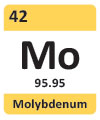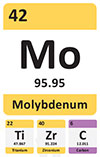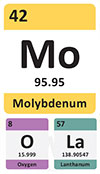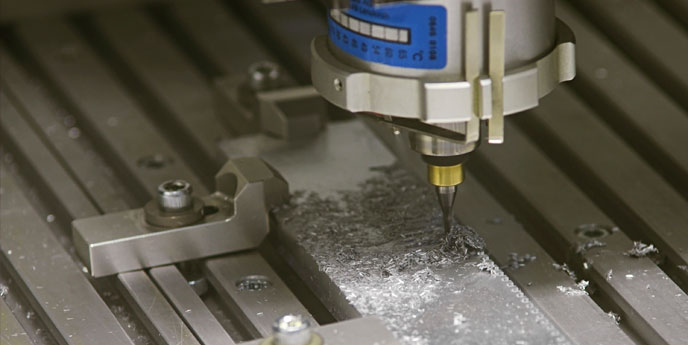GENERAL
Molybdenum (Mo), molybdenum lanthanum oxide (ML) and molybdenum TZM alloys can be machined by all of the common metal machining processes. No special equipment or procedures are required to produce parts with accurate dimensions and excellent finishes. Molybdenum may be machined to achieve simple to very complex, intricate components and parts.
TOOLS
The choice between high-speed steel and sintered carbide (C2 Grade) depends largely on production quantities. In either case, tool life is shorter than would be expected with steel because molybdenum is considerably more abrasive than steel at the same hardness, and molybdenum has a tendency to chip while being machined. High-speed steels are generally used for small quantities or for roughing cuts on uneven surfaces. The preferred carbide grades are the C2 types recommended for cast iron. Work should be firmly chucked; tools sharp and well supported; machines should be rigid, sufficiently powerful, and free from backlash.
LUBRICANTS
Many types of machining are done without lubrication; but cutting fluids may be used to extend tool life, increase cutting speeds, remove heat from the tool and work-piece, and remove fine molybdenum particles that wear the cutting edges of tools. When a lubricant is used, various high-chlorinated oils and solvents have proved satisfactory.
Soluble oils are very effective in hacksaw and band saw cutting operations, but not effective for turning, drilling, reaming, or tapping. Sulfur-base oils and highly chlorinated cutting oils are very effective in drilling, tapping, or thread chasing; and some machinist use these oils for finishing cuts in lathe operations to yield a smooth bright surface. Highly chlorinated cutting oils are most effective in reaming operations. Sulfur-base cutting oils cannot be used in machining electronic parts because of their deleterious effect on final properties.
SAWING & SHEARING
Molybdenum saws readily with high-speed steel band or hacksaws. The practice is similar to what normally is used on superalloys and no coolant is necessary, but use of a soluble oil coolant in the hacksaw or band saw cut will remove chips and lengthen blade life. High-speed steel blades with only the tooth area hardened are the most effective. Hand hacksawing is suitable for light gages only. On power hacksaws, cutting rates are about 80 strokes/min at 0.004 in. feed. With band saw equipment, 100 FPM with a 6-tooth blade at a pressure setting of 2 ½. About 1/8” is generally allowed for the kerf and 3/16 in. for camber on heavier sections. Flat patterns and formed molybdenum sheet sections can be cut on a band saw with a fine-tooth blade at very high speeds.
Abrasive cut-off wheels may also be employed. Wheel recommendations are indicated under grinding. Flame cutting, on the other hand, produces a very irregular edge.
Slitting and shearing may be done at room temperature for gages up to 0.025 in.; heavier sections should be heated to about 400/1000° F. Shearing is feasible on sections up to about 1/8 in. thickness or diameter. Shearing camber can normally be held to about 1/8 in. in five feet (on 3/32 in. sheet); heavier sections, however, will show considerable drag.
Sections over 3/8 in. thickness or diameter should be edge machined on a shaper or milling machine rather than sheared. Machining should be done along the edge rather than across. It may be desirable to hold between steel plates during machining to avoid chipping the edges.
TURNING
Previous studies indicated that a positive side rake angle in the range of 20/25° was essential; and other recommendations included a lead angle of 0° or slightly positive, relief angles of 7°, nose radii of 0.031/0.062 in., and honing all edges of the cutting tool at approximately 45° to the rake angles to give a 0.003/0.005 in. flat on cutting edge. A tough grade of straight tungsten carbide was found best with feeds of 0.005/0.010 iPro, while a general-purpose, C2 carbide grade could be used successfully on lighter finishing operations to obtain longer tool life.
Chlorinated oil and sulfur-base cutting oil can be used. If lubricants are not used, tool wear will be excessive. Sulfur-base oils cannot be used for machining electronic parts.
| SPEED (SFPM) | FEED (IPR) | DEPTH OF CUT, in. | ||
| Roughing | High Speed Steel | 45/75 | 0.0008/0.020 | 0.125/0.250 |
| C2 Carbide | 175/600 | 0.003/0.015 | 0.050/0.125 | |
| Finishing | C2 Carbide | 400/600 | 0.005/0.010 | 0.003/0.015 |
MILLING & SHAPING
Milling and shaping are preferably done with C2 carbide grade tools of the design normally used for cast iron. Where production quantities make it desirable to use high- speed steel, shaping is preferred to milling, as sharper tools with a generous positive rake last longer and are easier to regrind.
Face milling is effective for machining plane surfaces on molybdenum parts. Face milling cutters designed for machining cast iron with carbide tipped cutters are preferred and soluble cutting fluids are essential for economic tool life.
| SPEED (SFPM) | FEED (IPR) | DEPTH OF CUT, in. | ||
| Rough Milling | C2 Carbide | 110/150 | 0.003/0.005* | 0.050/0.010 |
| Finish Milling | C2 Carbide | 300/400 | 0.003/0.005* | 0.050/0.060 |
| Shaping | C2 Carbide | 25/50 | 0.003/0.010 | 0.005/0.060 |
DRILLING, REAMING & THREADING
In drilling, two-lipped carbide drills are generally used. Cutting oil should be used for all drilling, reaming, tapping, or threading operations. When high-speed or carbide-tipped drills are used, the fact that molybdenum has a lower coefficient of expansion than steel makes it particularly important to keep the drills sharp and cool. It is worthwhile to regrind frequently to avoid difficulty and delay from binding. Special precautions are necessary with deep holes (more than three times the drill diameter) because of the abrasive molybdenum chips. These precautions may involve carbide wear strips along the shank, relieving the drill, feeding the drill from below or use of pressurized coolant.
Reaming is difficult and tool life is very low compared to that obtained in machining heat-treated, low-alloy steel.
Threading can be done in various ways. Thread cutting with a single tool, grinding and roll threading are perhaps the most satisfactory. Die threading is not recommended, and tapping is not as easy as threading with a single-point tool. Coarse threads are preferred over fine threads, as very fine threads have a tendency to break. When coarse threads are developed, the depth of the thread needs to be only about 75% that normally cut in steel. For roll threading, the molybdenum should be heated to about 300° F.
| SPEED (SFPM) | FEED (IPR) | ||
| Roughing | High-Speed Steel | 25/150 | 0.003/0.005 |
| C2 Carbide | 40/175 | 0.005 | |
| Reaming | High-Speed Steel | 15/20 | 0.003/0.010 |
| C2 Carbide | 20/30 | 0.003/0.007 | |
| Tapping | High-Speed Steel | 15/20 | -- |
| C2 Carbide | 20/30 | -- | |
| Screw Cutting | High-Speed Steel | 30/40 | 0.003/0.005 |
| C2 Carbide | Not recommended |
SPECIAL MACHINING METHODS
Most special methods can be applied to molybdenum. Holes 1/8 in. diameter by 12 in. long can be electrical discharge machined (EDM) using brass electrodes and machining from both ends. Holes, 7 to 1000 microns in diameter, have been made in molybdenum by micromachining with “virtual electrode” in a 10% potassium-hydroxide electrolyte. Electron-beam machining (EBM) is also applicable for holes in this size range.
GRINDING, BUFFING & HONING
Molybdenum is relatively easy to grind with conventional machinery and practices to any degree of finish and tolerance desired. It is important to use sharply dressed wheels with generous amounts of coolant since localized overheating can produce cracks in the surface of molybdenum. Soluble oils in emulsions of 1:40 to 1:60 are typically recommended.
The following grinding procedures are suggested as starting points; necessary changes, if any, will be evident from the results obtained in preliminary work.
| OPERATION | SURFACE | SURFACE | CYLINDRICAL | CYLINDRICAL |
| Type of Grind | Dry | Wet | Wet or Dry | Wet |
| Wheel Speed (surface FPM) | 6000 | 6000 | 6500 | 6500 |
| Infeed (in./pass) | 0.002 | 0.005 | 0.001 | 0.0005 |
| Work Speed (surface FPM) | -- | -- | 100 | 100 |
| Table Speed (FPM) | 50 | 50 | 1/3* | 1/6* |
| Cross Feed (in./stroke) | 0.032 | 0.032 | -- | -- |
| Finish (micro in., RMS) | 10 | 20 | 30 | 12 |
*Width of wheel face/revolution of work
Consult your tool manufacturer or local distributor for the most current grinding, buffing, and honing models available. Tool manufacturers include Iscar, Kennametal Inc., Sandvik Coromant, etc.
ELECTROPOLISHING & PHOTO ETCHING
Molybdenum can be electropolished in a number of different solutions. Commercially the two most common solutions are a mixture of phosphoric acid and sulfuric acid or straight sulfuric acid. The first solution requires a much higher current density than the latter but also gives a better finish. Both baths are used at room temperature with molybdenum as the anode.
Photo etching of molybdenum is readily done by conventional means. The unexposed portion is etched either chemically or electrolytically. It is possible to make parts too intricate or complicated for die stamping by this method with absolute uniformity of all parts and remarkably close tolerances. Generally, photo etching is limited to sheet thickness from 0.001 to 0.010 in., with the minimum hole or mesh size never less than the thickness of the sheet.
| SOLUTION #1 | ||
| 4 GAL. PHOSPHORIC ACID 1 GAL. SULFURIC ACID 4 GAL. WATER | 10/14 AMP/SQ. IN. | Dip-in denatured alcohol prior to water rinsing. |
| SOLUTION #2 | ||
| 2 PARTS SULFURIC ACID 1 PART WATER | 100/300 AMP/SQ. FT. | Film of blue oxide formed; removed by immersion in alkaline cleaner or caustic-soda solution. |




